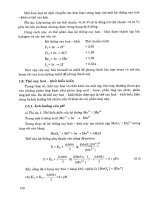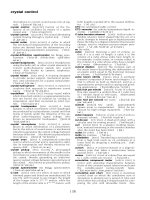Engineering Tribology Episode 1 Part 7 pptx
Bạn đang xem bản rút gọn của tài liệu. Xem và tải ngay bản đầy đủ của tài liệu tại đây (742.75 KB, 25 trang )
HYDRODYNAMIC LUBRICATION 125
⌠
⌡
0
L
dy
()
h
3
12η
+
∂p
∂x
Uh
2
−Q
x
=
(4.67)
The boundary conditions shown in Figure 4.9 are:
dp
dx
= 0 at h = (point of maximum pressure)h
¯
(4.68)
substituting into (4.67) the flow is:
⌠
⌡
0
L
dy
U
2
Q
x
=
h
¯
(4.69)
substituting for ‘h’ (eq. 4.45):
⌠
⌡
0
L
dy
U
2
Q
x
= 2h
0
K + 1
K + 2
()
and simplifying yields the lubricant flow per unit length:
= Uh
0
K + 1
K + 2
()
Q
x
L
(4.70)
Lubricant flow is therefore determined by sliding speed and film geometry but not by
viscosity or length in the direction of sliding. In real bearings, however, ‘K’ and ‘h
0
’ are
usually indirectly affected by oil viscosity and the length in the direction of sliding. For
example, for a typical high speed pad bearing U = 10 [m/s], h
0
= 0.1 [mm] and ‘K ’ is
approximately 1.5. This gives a lubricant flow of 0.0007 [m
2
/s] (flow per unit length) or 0.7
[litres/sm]. If the bearing length ‘L’ is 0.2 [m] then 0.14 [litres/s] of lubricant is required to
maintain lubrication.
Infinite Rayleigh Step Bearing
In 1918 Lord Rayleigh discovered a method of introducing a fixed variation in the lubricant
film thickness without the use of tilting [5]. His new design moved away from the well
established trend that lubricant film thickness variation can only be produced by tilting the
pad. Rayleigh introduced a film geometry where a step divided the film into two levels of
film thickness. The geometry of the Rayleigh step bearing is shown in Figure 4.11. This film
geometry was advocated as simpler to manufacture than arrangements which allowed very
small controlled angles of tilt.
The inlet and the outlet conditions are controlled by the maximum and minimum film
thicknesses ‘h
1
’, and ‘h
0
’ respectively.
In this bearing there are two surfaces parallel to the bottom surface which divide the
lubricant film into two zones as shown in Figure 4.11. The pressure gradients generated in
each of the zones are constant, i.e. dp/dx = constant. This condition shortens the analysis
considerably since the pressure gradients can be written directly from Figure 4.11.
TEAM LRN
126 ENGINEERING TRIBOLOGY
p
max
p
z
x
h
0
h
1
B
2
B
B
1
ZONE 2 ZONE 1
U
FIGURE 4.11 Geometry of the Rayleigh step bearing.
dp
dx
()
1
ZONE 1 = −
p
max
B
1
(4.71)
=
p
max
B
2
dp
dx
()
2
ZONE 2
(4.72)
Note that physically, for the configuration shown in Figure 4.11,
dp
dx
1
is positive while
dp
dx
2
is
negative. In the entry zone the oil flow per unit length (eq. 4.18) into the bearing is (Note that
the velocity ‘U’ is negative):
q
1
= −
h
1
3
12η
−
Uh
1
2
dp
dx
()
1
substituting for pressure gradient (eq. 4.71) gives flow into the bearing:
q
1
=
12η
−
Uh
1
2
p
max
B
1
h
1
3
(4.73)
On the other hand in the exit zone the lubricant flow per unit length is:
q
2
= −
h
0
3
12η
−
Uh
0
2
dp
dx
()
2
substituting for pressure gradient (eq. 4.72):
q
2
= −
h
0
3
12η
−
Uh
0
2
p
max
B
2
(4.74)
For continuity of flow:
TEAM LRN
HYDRODYNAMIC LUBRICATION 127
q
1
= q
2
Thus:
12η
−
Uh
1
2
p
max
B
1
= −
h
0
3
12η
−
Uh
0
2
p
max
B
2
h
1
3
Simplifying and rearranging gives:
p
max
=
+
h
0
3
B
2
()
h
1
3
B
1
6Uη(h
1
− h
0
)
(4.75)
Load capacity per unit length is simply the area under the pressure triangle:
=
1
2
p
max
B
W
L
(4.76)
Frequently in the literature ‘p
max
’ is quoted as ‘p
s
’ for the step. Both ratios h
1
/h
0
and B
1
/B
2
can
vary and it was found that these bearings give the maximum load capacity when the
following ratios are selected [4]:
h
1
h
0
= 1.87 and
B
1
B
2
= 2.588
An interesting story is that Lord Rayleigh first tried his bearing using two pennies (19th
century coinage ~25 [mm] in diameter) [3]. Grooves were cut with a file and on one penny,
the recessed areas were produced by etching with nitric acid. The other contact surface was
left flat. Prepared in such a manner, the bearing worked!
The principal advantage of these bearings is that they give higher load capacity than linear
pads. At their optimum configuration the load coefficient is 6W* = 0.206 as opposed to 0.1602
for infinite linear pad bearings while the coefficient of friction is almost the same. Despite the
distinct advantages of other bearing types the Rayleigh step profile is still used in thrust and
pad bearings. The principal reason for this practice is the ease of manufacture of the Rayleigh
step as compared to the pivoted Michell pad in particular. Whereas the Michell pad requires
an elaborate system of pivots, the Rayleigh step can be made by applying relatively simple
machining techniques or even by covering one half of a plane surface by protective tape and
then exposing the whole surface to sand-blasting or chemical etching. When the protective
covering is removed, a completed Rayleigh step bearing is obtained.
The disadvantage of the Rayleigh bearing, however, is that as the step wears out then the
hydrodynamic pressure falls and the bearing ceases to function as required. For bearings of
finite length, the lubricant leaks more easily to the sides of the bearing than for a linear
sloping pad which results in a lower load capacity. In other words at, e.g. L/B = 1, the
Rayleigh pad has a lower value of ‘W*’ than the linear sloping pad despite the fact that the
opposite is the case at L/B » 1. To obtain higher efficiency from a Rayleigh bearing it is
necessary to introduce side lands on the edges of the bearing [6]. An example of this
modification is shown in Figure 4.12.
TEAM LRN
128 ENGINEERING TRIBOLOGY
Inlet
Outlet
Modified
Rayleigh
step
Side land
flow restrictor
FIGURE 4.12 Modified Rayleigh pad geometry for bearings of finite length.
Other Wedge Geometries of Infinite Pad Bearings
Many different wedge shapes have been analysed and tried. Some of these designs were
successful and applied in practice but most of them were destined to remain undisturbed on
the shelf. The geometry of wedges most commonly applied in practice are briefly described
below.
· Tapered Land Wedge
An example of the tapered land wedge is shown in Figure 4.13. At the end of the bearing a
flat, called a ‘land’, is machined. This is a very practical design since it accommodates the
wear that would occur on a completely tapered wedge when the bearing decelerates to stop or
accelerates from rest.
The film geometry is similar to both a linear and a Rayleigh pad bearing. Thus the bearing
must be treated in two sections: the section with a taper first and then the parallel section,
this is analogous to the Rayleigh step. The film geometry in the tapered section is described
by:
h = h
0
()
Kx
B
1
1 +
The load capacity is strongly dependent on the amount of taper [3] and it was found that the
optimum bearing configuration for maximum load capacity is achieved for the ratios
B
1
/B
2
= 0.8 and h
1
/h
0
= 2.25 [4]. In this bearing, the combination of two geometries of linear
and Rayleigh pad bearings results in the load coefficient of 6W* = 0.192 which is slightly
lower than that for the step bearing and higher than that for the linear pad bearing.
z
x
h
0
h
1
B
2
B
B
1
U
FIGURE 4.13 Geometry of the tapered land bearing.
TEAM LRN
HYDRODYNAMIC LUBRICATION 129
· Parabolic Wedge
This particular film geometry is employed in the piston rings of combustion engines. The
circumference of a piston ring is usually very much greater than either of its dimensions in
the direction of travel so that the infinitely long bearing approximation is very appropriate.
An example of the parabolic wedge is shown in Figure 4.14 while the pressure profile of an
unbounded parabolic bearing is shown in Figure 4.15.
z
x
h
0
h
1
B
U
a)
b)
B
Crankcase
Combustion
chamber
z
U
Lubricant
Piston ring
h
0
h
1
Piston
Cylinder liner
FIGURE 4.14 Geometry of the parabolic wedge bearing (a) and an example of its application in
piston ring (b) [65].
The film geometry is described by the equation:
h = h
0
+ (1 + x/B
c
)
n
(h
1
− h
0
)
where:
n is a constant and equals 2 for a simple parabolic profile;
B
c
is a characteristic width which is usually, but not always, equal to the bearing
width ‘B’ [m];
TEAM LRN
130 ENGINEERING TRIBOLOGY
x is the distance along the ‘x’ axis starting from the minimum film thickness [m].
In this bearing there is no specific inlet and instead, beyond a certain distance, film thickness
is so large that it becomes irrelevant to the pressure field close to the minimum film
thickness. More information about the parabolic pressure profile can be found in [55].
p
z
x
h
0
h
1
B
U
Half-parabolic
bearing profile
FIGURE 4.15 Pressure profile in a parabolic wedge bearing.
The parabolic profile has the advantage that it tends to be self-perpetuating under wear since
the piston ring tends to rock inside its groove during reciprocating movement and causes
preferential wear of the edges of the ring. If the wear is well advanced, or the edges of the
piston ring have been deliberately rounded, then the starting point of hydrodynamic
pressure generation cannot be precisely determined. Under these conditions, the model of
parabolic film profile is very appropriate.
· Parallel Surface Bearings
The low friction obtained during operation of parallel surface bearings appears to contradict
the Reynolds equation since no wedge or step has been included in the bearing. It was found
by Beauchamp Tower in 1891 that a bearing could be made of two flat parallel surfaces with
one of them having four radial grooves cut in it [16]. The surfaces were parallel with no
apparent wedge, so theoretically they should not support any load under sliding without
severe wear and friction. Low friction and negligible wear was, however, obtained. Research
conducted later showed that the thermal distortions of the bearing surfaces were sufficiently
large to form a lubricating wedge [3,4]. These types of bearings are still used to support small
intermittent loads. Thermal distortion of the bearing surface is the result of a temperature
gradient between the relatively hot sliding surfaces and the cooler outer surfaces of the
bearing. Since most bearing materials have considerable thermal expansion, curvature or
‘crowning’ of the bearing surfaces result. The distorted profile enables hydrodynamic
pressure generation to occur. The principle is illustrated in Figure 4.16.
It is also possible for a parallel surface bearing to deform to produce a hydrodynamic wedge
without any thermal deformation. A nominally parallel surface bearing consisting of a
TEAM LRN
HYDRODYNAMIC LUBRICATION 131
cantilever supported rigidly at one end is an effective bearing [17]. A maximum
dimensionless load capacity ‘6W*’ of 0.16 can be obtained by this means.
I
N
T
E
R
M
E
D
I
A
T
E
T
E
M
P
E
R
A
T
U
R
E
H
I
G
H
S
U
R
F
A
C
E
T
E
M
P
E
R
A
T
U
R
E
Pad
Frictional heat
Lubricating
film
Counterface
Thermally induced wedge
Bearing shape
after thermal
distortion
Original
shape
Cooling by convection
to air
Temperature
Ambient
temperature
FIGURE 4.16 Thermal deformation of a parallel surface bearing to allow hydrodynamic
lubrication.
· Spiral Groove Bearing
When the step is curved around a circular boundary, a very useful form of bearing results
which is known as the spiral groove bearing and is shown in Figure 4.17.
As illustrated in Figure 4.17, two forms of the spiral groove bearing exist; in one the centre of
the spiral has the lower film thickness and is known as the ‘closed form’, in the other the
centre of the spiral has the larger film thickness and is known as the ‘open form’.
Closed form bearing Open form bearing
FIGURE 4.17 Film geometry of spiral groove bearings (dark areas have lower film thickness).
The spiral groove bearing is often constructed in pairs of opposing spirals to allow reverse
rotation with positive pressure generation and load capacity. The theory of spiral groove
thrust bearings is discussed in detail in [12].
TEAM LRN
132 ENGINEERING TRIBOLOGY
Spiral groove bearings are effective and relatively cheap alternatives for use as thrust
bearings. When made from silicon carbide ceramic these bearings were found to work
reliably in the presence of abrasive slurry which also acted as a lubricant [13].
Finite Pad Bearings
As indicated earlier the long bearing approximation provides adequate estimates of load
capacity and friction for the ratios of L/B > 3. The bearings with a ratio 1/3 < L/B < 3 are
called finite bearings. For these bearings all the important parameters such as pressure, load
capacity, friction force and lubricant flow are usually computed by numerical methods. In
certain limited cases, however, it is possible to derive analytical expressions of load capacity,
friction force, etc. for finite bearings. A great deal of intellectual effort was expended on this
task before computers were available. The disadvantage of the analytical approach is that it is
impossible at present to incorporate additional factors such as lubricant heating. In the next
chapter, a widely used numerical method, called the Finite Difference method, is introduced
and its applications to bearing analysis are illustrated by examples. At this stage, however, it
is helpful to consider the application of data generated by numerical bearing analysis.
In the literature computed data are presented in the forms of graphs or data sheets. An
example is shown in Figure 4.18 [4] where the load coefficient ‘6W*’ is plotted against the
convergence ratio ‘K’ for various L/B ratios for rectangular linear pads.
0 1 2 3 4 5
0
0.05
0.10
0.15
6W* =
W/L
ηU
h
0
2
B
2
K = (h
1
/h
0
) − 1
L/B = ∞
= 2
= 1.5
= 1
= 0.75
= 0.5
FIGURE 4.18 Variation of load capacity with convergence ratio for various L/B ratios for
rectangular linear pads [4].
The load capacity of a bearing is then calculated by finding the appropriate L/B value or by
interpolation where necessary. For L/B ratios greater than 2, it can be assumed that values of
‘6W*’ for L/B = 3 are very close to values for L/B = ∞. The value of load is found from ‘6W*’
by multiplying it by the factor B
2
LUη / h
0
2
.
Pads are usually employed in thrust bearings. They can also be found in pivoted pad journal
bearings which are often used in machine tool applications. In thrust bearings the pads are
usually not square since this would be impractical. The collar is circular and they are part of a
circle. They are called sector-shape pads and were analysed by Pinkus [3,7] in 1958. The
analysis is much more complex than that of rectangular pads. In practical engineering cases,
however, it is usually sufficiently accurate to assume that the pad is of rectangular shape,
TEAM LRN
HYDRODYNAMIC LUBRICATION 133
since the error of this approximation is less than 10%. More information on these and more
specialized pads can be found in the literature [e.g. 7-9].
It can be seen from Figure 4.18 that for the lower L/B ratios the load capacity of the bearing is
less sensitive to changes in the h
1
/h
0
ratios, i.e. the bearing is more stable. The continuous
changes of h
1
/h
0
ratios with load pose the greatest problem in this type of bearing. The way in
which this problem has been overcome will be discussed in the next section.
EXAMPLE
Calculate the maximum load capacity for a square pad of B = 0.1 [m] side dimension.
Assume a sliding speed of U = 10 [m/s], lubricant viscosity η = 0.05 [Pas] and minimum
film thickness h
0
= 10
-4
[m].
From Figure 4.18; 6W* = 0.07 hence W = 0.07
0.1
3
×
10
×
0.05
10
-4
2
= 3.5 [kN]
Pivoted Pad Bearing
The pivoted pad bearing allows the angle of tilt to vary with load as this has been found to
improve the load capacity of the bearing. The problem of a limited load capacity caused by a
fixed level of tilt can be illustrated by considering changes in load capacity when the load and
‘W*’ are increased progressively from zero. Until the pad bearing reaches its optimum h
1
/h
0
or ‘K’ ratios, the load capacity balances the applied load. If the load is increased further then
‘K’ will increase as the tilt (h
1
- h
0
) becomes greater than h
0
. Non-dimensional load ‘W*’ then
starts to decline since ‘K’ shifts towards the right as can be seen from Figure 4.10. The real
load, however, as opposed to ‘W*’, may still rise in theory because of the strong multiplying
effect of ‘h
0
-2
’ but in practice there are other factors such as distortion of the pad and heating of
the lubricant caused by the more intensive shearing at thin film thicknesses which render
the decline in ‘W*’ with ‘K’ much more severe than shown in Figure 4.10.
The changes in ‘W*’ with ‘K’ posed a very serious engineering problem since it was not
possible to run the bearing at the optimal h
1
/h
0
ratio. The problem was eventually solved by
an Australian engineer A.G.M. Michell. During his work as consulting engineer he saw the
limitations of conventional thrust bearings in which metal-to-metal contact frequently
occurred. The existing designs of thrust bearings were also complicated and large in size.
For example, a thrust bearing for a single propeller ship could have ten or more collar
bearings. There were obvious difficulties in maintaining the close tolerances to ensure a
uniform contact pressure on the collars. Consequently the bearings were oversized, noisy,
inefficient and not particularly reliable.
Michell came up with an ingenious solution which was a major breakthrough in lubrication
science viz the pivoted pad bearing [10]. His design required only one thrust collar on a ship
propeller shaft instead of the ten previously required. This simplification enabled a
considerable reduction in noise and fuel consumption and less space was needed for the
bearing. Michell patented his bearing in 1905 and a working model was installed in pumps at
Cohuna on the Murray River in 1907 [11].
In 1910, Kingsbury independently patented a similar bearing in the United States. The only
difference was that the pads of his bearing were pivoted centrally whereas in the Michell
bearing they were offset as shown schematically in Figure 4.19. Also Kingsbury's approach
was empirical, lacking the rigour and elegance of Michell's mathematical analysis [11].
TEAM LRN
134 ENGINEERING TRIBOLOGY
Load
U
W
B
L
Pivot Pads
Side view
Bottom view
a)
Side view
Bottom view
b)
FIGURE 4.19 Schematic diagrams of the pivoted bearings a) Michell offset line pivot, b)
Kingsbury button point pivot (adapted from [67]).
Kingsbury's design, however, made allowance for misalignment between the mobile and
stationary sides of the bearing by the use of a point pivot rather than a linear pivot.
The greatest advantage of pivoted pad bearings over fixed pad bearings is that the ratio h
1
/h
0
always remains the same, whatever the load. These bearings self-adjust their film thickness
geometry with load to give optimum performance. The pivot should be placed in the centre
of pressure, otherwise the bearing becomes unstable. The centre of pressure and hence the
pivot position can easily be found by taking moments about the trailing edge of the bearing as
shown in Figure 4.20.
The moment of force about the bearing outlet is:
WX =
⌠
⌡
0
L
pxdxdy
⌠
⌡
0
B
or per unit length:
= pxdx
⌠
⌡
0
B
L
WX
(4.77)
TEAM LRN
HYDRODYNAMIC LUBRICATION 135
substituting for ‘p’ (eq. 4.46), ‘x’ (from eq. 4.38) and ‘dx’ (eq. 4.39) gives:
Kh
0
1
h
h
0
h
2
+
(K + 1)
(K + 2)
+
1
h
0
(K + 2)
−
()
6UηB
=
L
WX
⌠
⌡
h
0
h
1
K
2
h
0
2
B
2
(h − h
0
)dh
(4.78)
After substituting for W/L (eq. 4.50) into (4.78) and manipulating the equation, the position
of pivot from the trailing edge of the bearing is found.
2K[(2 + K)ln(1 + K) − 2K)]
2(3 + K)(1 + K)ln(1 + K) − K(6 + 5K)
= 1 −
B
X
(4.79)
p
max
p
z
x
h
0
h
1
U
X
B
x dx
W
FIGURE 4.20 Position of pivot in a Michell pad bearing.
It can be seen that the position of the pivot depends only on the convergence ratio ‘K’ or the
ratio of film thicknesses. Thus the film thickness ratio ‘K’ remains constant once the position
of the pivot is decided. Some calculated values of the pivot position for various convergence
ratios are shown in Table 4.2. It can be seen from Table 4.2 that for an infinite linear pad
bearing at its optimum h
1
/h
0
ratio of 2.2 the pivot position is 0.422B from the trailing edge.
Inlet Boundary Conditions in Pad Bearing Analysis
Finally, the question of pad boundary conditions has to be discussed in more detail. It is
usually assumed for the purpose of analysis that the inlet pressure to a pad bearing is either
zero or identical to atmospheric pressure. This assumption ignores the possibility of an
inertial pressure rise at the bearing inlet. Such an inertial pressure rise is schematically
shown in Figure 4.21 and is the result of deceleration or acceleration of the lubricant when it
flows over or around the bearing pad.
This pressure rise is often referred to as the ‘Ram Effect’ and can be significant at high sliding
speeds. The pressure rise has been measured experimentally [14] and modelled by
computational methods [15]. The pressure rise can be estimated from the following equation:
TEAM LRN
136 ENGINEERING TRIBOLOGY
TABLE 4.2 Pivot position for various ‘K’ ratios.
0 0 1
0.482 0.2
0.466 0.4
0.453 0.6
0.442 0.8
0.431 1.0
0.422 1.2
0.414 1.4
0.406 1.6
0.399 1.8
0.393 2.0
0.387 2.2
0.381 2.4
0.376 2.6
0.371 2.8
0.366 3.0
1.2
1.4
1.6
1.8
2.0
2.2
2.4
2.6
2.8
3.0
3.2
3.4
3.6
3.8
4.0
X
B
K
h
1
h
0
Pad Actual pressure
profile
Pressure profile with
zero inlet pressure
Pressure rise due to
diversion of
lubricant flow
∆p
U
Counterface
FIGURE 4.21 Stagnation pressure rise at the inlet to a pad bearing.
=
A
Re
∆p
ρU
2
+ B
where:
∆p is the pressure rise [Pa];
ρ is the lubricant density [kg/m
3
];
TEAM LRN
HYDRODYNAMIC LUBRICATION 137
U is the sliding speed [m/s];
Re is the Reynolds number defined as Re = h / ρUh
1
;
A, B are constants.
A graph of the dimensionless pressure rise versus the reciprocal of the Reynolds number is
shown in Figure 4.22 for two bearing geometries.
1/Re
∆p
ρU
2
0.01 0.1 1 10
0.01
0.1
1
10
Closely spaced pads
Space between the
pads = 3.175 [mm]
Widely spaced pads
Space between the
pads = 49.72 [mm]
FIGURE 4.22 Dimensionless bearing inlet pressure rise versus the reciprocal of the Reynolds
number [15].
It can be seen that for a bearing with a standard geometry, e.g. a planar wall normal to the
direction of sliding and widely spaced pads, the pressure increase is high, particularly at low
Reynolds' numbers. On the other hand, for the bearing with a 45° chamfer at the inlet and a
smaller distance between the pads this effect is reduced. The difference in pressure is the
result of the varying mode of lubricant flow at the bearing inlet. This effect is a prime
example of the important role the bearing inlet conditions play in controlling the bearing
characteristics. Examples of measured constant values of ‘A’ and ‘B’ can be found in [15].
The effect of a positive inlet pressure is to raise the load capacity of both fixed inclination
pads and pivoted pads [63]. In some cases, the increase in load capacity is predicted to be quite
large, e.g. a doubling of load capacity compared to that calculated with the simple assumption
of zero inlet pressure. Unless suction is deliberately applied, the inlet pressure is always
positive and, in effect, provides a margin of safety for the design of pad bearings based on
classical hydrodynamic theory.
4.4 CONVERGING-DIVERGING WEDGES
In the previous sections an infinite linear pad bearing was considered where the geometry
was merely a converging wedge. In many engineering applications, however, such as in
journal bearings, the situation can be a little more complicated; the wedge can initially
converge and then, after reaching a minimum, diverge. The question is: what will then
happen? How would this affect the generated pressure and consequently the load capacity?
The overall approach to the analysis in such cases is unaffected. The first step is to define the
film geometry and then the pressure distribution, load capacity and other important
TEAM LRN
138 ENGINEERING TRIBOLOGY
parameters can be obtained by integrating the Reynolds equation. This problem can be
illustrated by initially considering the secant wedge. It has been suggested that this wedge is
the most useful for teaching purposes because of its simplicity [4]. It also gives a clear
introduction to the more complicated geometry of journal bearings.
Consider a converging-diverging wedge described by a secant function such as that illustrated
in Figure 4.23.
z
x,θ
h
0
h
¯
h
U
p
max
p
B
−π
2
π
2
θ0 θ
¯
Diverging
region
Converging
region
FIGURE 4.23 Geometry of a secant wedge. Note the negative velocity ‘U’.
Bearing Geometry
The wedge profile is described by the function:
h = h
0
secθ
(4.80)
where:
θ=
B
x
2
π
(4.81)
and the minimum film thickness ‘h
0
’ occurs when θ = 0.
Pressure Distribution
The Reynolds equation for the long bearing approximation (4.27) can be used since the
pressure gradient acting along the ‘x’ axis is dominant:
dp
dx
h −
h
3
= 6Uη
h
¯
TEAM LRN
HYDRODYNAMIC LUBRICATION 139
substituting for ‘h’ and ‘
h’ which is defined as:
= h
0
sech
¯¯
θ
gives:
dp
dx
h
0
(secθ−sec
¯
θ
h
0
3
sec
3
θ
= 6Uη
)
In a similar manner to the previously analysed linear bearing, ‘
θ
’ gives the position at which
the maximum pressure occurs at the corresponding film thickness ‘
h’. Differentiating (4.81):
2B
π
dx = dθ
(4.82)
and substituting, gives
h
0
2
()
6Uη
dp = dθ
2B
π
sec
¯
θ
sec
3
θ
1
sec
2
θ
−
which can be integrated. Remembering the standard integrals:
dθ =
⌠
⌡
1
sec
2
θ
cos
2
θdθ =
⌠
⌡
1
2
(θ+ sinθcosθ) and
dθ =
⌠
⌡
1
sec
3
θ
cos
3
θdθ =
⌠
⌡
1
3
(sinθcos
2
θ + 2sinθ)
the pressure distribution in the secant wedge is given by:
h
0
2
[]
6Uη
p =
2B
π
sec
¯
θ
3
1
2
(θ+ sinθcosθ) − (sinθcos
2
θ + 2sinθ) + C
(4.83)
which can then be expressed in terms of a non-dimensional pressure:
[]
p* =
2
π
sec
¯
θ
3
1
2
(θ+ sinθcosθ) − (sinθcos
2
θ + 2sinθ) + C
(4.84)
where:
6UηB
h
0
2
p* = p
(4.85)
There are two constants ‘
θ
’ and ‘C’ and some boundary conditions are needed in order to
determine them. Throughout the literature three sets of boundary conditions known as the
Full-Sommerfeld, Half-Sommerfeld and Reynolds are widely quoted, and these are described
below.
TEAM LRN
140 ENGINEERING TRIBOLOGY
· Full-Sommerfeld Boundary Condition
The Full-Sommerfeld condition [18] is perhaps the most obvious and simplest of the
boundary conditions. It assumes that the pressure is equal to zero at the edges of the wedge,
i.e.:
2
π
p = 0 at θ = ±
substituting into (4.83) the constants ‘C’ and ‘sec
θ
’ can be determined:
C = 0
8
3
=sec
¯
θ π = 1.1781
(4.86)
It can be seen from (4.86) that the pressure reaches its maximum at
θ
= 31.92° and substituting
this into (4.84) yields:
[]
p* =
2
π
π
8
1
2
(θ+ sinθcosθ) − (sinθcos
2
θ + 2sinθ)
(4.87)
The pressure distribution for the Full-Sommerfeld condition is shown in Figure 4.24.
z
x,θ
h
0
U
p
B
−π
2
θ0
¯
−p
max
π
2
h
¯
p
max
FIGURE 4.24 Pressure distribution with the Full-Sommerfeld boundary condition.
TEAM LRN
HYDRODYNAMIC LUBRICATION 141
It can be seen from Figure 4.24 that the Full-Sommerfeld condition is unlikely to apply to real
fluids. There is a large negative pressure in the diverging region which is the mirror image
of the pressure distribution in the converging region. As discussed later, large negative
pressures are physically unrealistic. Furthermore, because of these opposing negative and
positive pressures the predicted load capacity is zero. On the other hand, it has been shown
that the hydrodynamic lubrication film is very efficient under such geometries and is capable
of supporting a load. Hence some other boundary condition should apply.
· Half-Sommerfeld Boundary Condition
To allow for the reality that large negative pressures do not exist in a diverging region
because of the limitations of lubricants, a simple model has been adopted which states that
the predicted negative pressures are in fact equal to zero, i.e.:
p = 0 for x ≤ 0
and the Half-Sommerfeld boundary condition is:
2
π
p = 0 at θ =
p = 0 at θ = 0
2
π
p = 0 at − < θ < 0
(4.88)
Substituting this condition gives a pressure distribution similar to the Full-Sommerfeld with
the only difference being that in the diverging region the pressure remains constant and
equal to zero as shown in Figure 4.25.
z
x,θ
h
0
h
¯
U
p
max
p
B
−π
2
π
2
θ0
¯
FIGURE 4.25 Pressure distribution with the Half-Sommerfeld boundary condition.
From the engineering view point the Half-Sommerfeld boundary condition is very simple
and easy to apply. Its physical basis, however, is erroneous since discontinuity of flow at the
TEAM LRN
142 ENGINEERING TRIBOLOGY
boundary between the zero and non-zero pressure regions is implied. The discrepancy
between the flow of lubricant out of the non-zero pressure region and into the zero pressure
region is analysed below.
Flow rate per unit length into the wedge is (eq. 4.18):
q
x
= −
h
3
12η
dp
dx
+ U
h
2
since:
dp
d
x
= 0 at
h
then the flow rate into the bearing is given by:
q
x
in
=
U
2
h
¯
=
Uh
0
sec
2
θ
¯
substituting for ‘sec
θ
’ (eq. 4.86) yields:
q
x
in
= 1.1781
Uh
0
2
(4.89)
Since in the diverging region pressure is continuously equal to zero then:
= 0 for all x ≤ 0
dp
dx
This means that:
= 0 at h
0
dp
dx
and the flow out of the bearing in the diverging region is:
q
x
out
=
Uh
0
2
(4.90)
For continuity of flow:
q
x
in
= q
x
out
but this is clearly not the case, since:
1.1781
Uh
0
2
≠
Uh
0
2
In spite of the lack of flow continuity, the Half-Sommerfeld boundary condition is used in
some engineering calculations, as the errors introduced are small.
Summarizing, both conditions analysed so far are not physically realistic, since one leads to
predictions of large negative pressures and the other to a discontinuity of flow. A more exact
TEAM LRN
HYDRODYNAMIC LUBRICATION 143
solution is required before accurate estimations of load capacity, bearing friction and lubricant
flow rate can be obtained.
· Reynolds Boundary Condition
The solution to the problem was suggested by Reynolds who simply stated that there are no
negative pressures and that at the boundary between zero and non-zero pressure the
following condition should apply:
p =
dp
dx
= 0
Reynolds assumed that in the diverging region, at film thickness ‘h’ (located at ‘-
θ
’) the
pressure gradient dp/dx and the pressure are equal to zero. In this region the lubricating film
starts to divide into streamers of lubricant and air spaces and
h = h
cav
(where the subscript
‘cav’ stands for cavitation). As the film thickness continues to increase, the proportion of
space occupied by lubricant streamers is correspondingly reduced. The balance between
streamer volume and volume of air space is determined by the condition that the lubricant
flow remains constant within the zero pressure region. The Reynolds boundary condition for
an infinitely long bearing is shown in Figure 4.26 which is a plan view of the hydrodynamic
pressure field.
z
x,θ
h
0
U
p
B
−π
2
0
dp
dx
= 0
Streamers
Continuous film
π
2
h
¯
θ
¯
−
dp
dx
p == 0
h
¯
p
max
θ
¯
FIGURE 4.26 Pressure distribution with Reynolds boundary condition.
It can be seen from Figure 4.26 that the Reynolds boundary condition assumes:
TEAM LRN
144 ENGINEERING TRIBOLOGY
2
π
p = 0 at θ =
p = 0 at θ = − when
¯
θ=0
dp
dx
(4.91)
Substituting the above boundary condition into equation (4.83) yields the constants ‘C’ and
‘sec
θ
’:
C =−0.03685
sec = 1.1228
¯
θ
(4.92)
Substituting into (4.84) gives the non-dimensional pressure for the Reynolds boundary
condition:
[]
p* =
2
π
1
2
(θ+ sinθcosθ) − 0.3743(sinθcos
2
θ + 2sinθ) − 0.03685
(4.93)
It can also be found from (4.92) that the maximum pressure is reached at
θ
= 27.05° and is
zero at
θ
= -27.05° (Figure 4.26).
Load Capacity
As already mentioned the total load that the bearing will support is obtained by integrating
over the pressure field and the load per unit length is:
= pdx
⌠
⌡
0
B
L
W
Substituting for ‘dx’ (4.82):
= pdθ
⌠
⌡
θ
1
θ
2
L
W
π
2B
(4.94)
where ‘θ
1
’ and ‘θ
2
’ mark the extent of the pressure field, which depends on the boundary
condition applied. Substituting for ‘p’ (4.83):
h
0
2
[]
6Uη 2B
π
sec
¯
θ
3
1
2
(θ+ sinθcosθ) − (sinθcos
2
θ + 2sinθ) + C=
L
W
2B
π
dθ
⌠
⌡
θ
1
θ
2
Integrating yields:
h
0
2
6UηB
2
sec
¯
θ
3
θ
2
4
=
L
W
4
π
2
θ
1
θ
2
+
sin
2
θ
4
+
()
cos
3
θ
3
+ 2cosθ+Cθ
(4.95)
TEAM LRN
HYDRODYNAMIC LUBRICATION 145
Which is the total load per unit length that the bearing will support. In terms of non-
dimensional load (4.95) is expressed as:
sec
¯
θ
3
θ
2
4
W* =
4
π
2
θ
1
θ
2
+
sin
2
θ
4
+
()
cos
3
θ
3
+ 2cosθ+Cθ
(4.96)
where:
6UηB
2
L
h
0
2
W* = W
Substituting for the appropriate values of ‘θ’ defining the extent of the pressure field and
constants ‘C’ and ‘sec
θ
’, the non-dimensional load can easily be determined for all the
conditions analysed. The results obtained are summarized in Table 4.3.
T
ABLE 4.3 Extent of pressure fields and non-dimensional loads for Full-Sommerfeld, Half-
Sommerfeld and Reynolds boundary conditions.
Full - Sommerfeld
Half - Sommerfeld
Reynolds
The extent of the
pressure field
Constants
W*
θ
1
θ
2
sec Cθ
−90° 90° 1.1781 0 0
0° 90° 1.1781 0 0.020041
−27.05° 90° 1.1228 −0.03685 0.028438
It can be seen from Table 4.3 that with the Full-Sommerfeld boundary condition there is no
resultant load. The reason for this becomes clear after examining Figure 4.24. The positive
pressure field is counterbalanced by a negative pressure field, leaving only a turning
moment. It can also be noticed that the pressure field and therefore the load found for the
Reynolds boundary condition is higher than for the Full and Half-Sommerfeld boundary
conditions. This is shown in Figure 4.27 [4] where the pressure distributions, for all three
conditions, are superimposed.
The Reynolds boundary condition gives the most accurate results of all the boundary
conditions presented in this section, but other more specialised conditions have been
suggested and will be discussed in Chapter 5 on ‘Computational Hydrodynamics’. Although
it is relatively accurate, the Reynolds boundary condition is still an approximation to the
transition from full fluid flow to cavitated flow. It is also relatively difficult to apply in
analytical solutions of realistic film geometries. The mathematics can become quite involved
especially when locating the position of the boundary. Thus, as mentioned already, the Half-
Sommerfeld boundary condition can be employed since it gives acceptable estimates of load
capacity. The Reynolds boundary condition is, however, easily incorporated into numerical
solutions of hydrodynamic pressure fields as shown in the next chapter on ‘Computational
Hydrodynamics’ and for this reason is the most widely used boundary condition.
TEAM LRN
146 ENGINEERING TRIBOLOGY
z
x,θ
h
0
U
p
Half-Sommerfeld
Sommerfeld
Reynolds
Full-
FIGURE 4.27 Pressure fields for Full-Sommerfeld, Half-Sommerfeld and Reynolds boundary
conditions [4].
4.5 JOURNAL BEARINGS
Journal bearings are very common engineering components and are used in almost all types
of machinery. Combustion engines and turbines virtually depend on journal bearings to
obtain high efficiency and reliability. A journal bearing consists of a shaft rotating within a
stationary bush. The hydrodynamic film which supports the load is generated between the
moving surfaces of the shaft and the bush.
There are two basic aspects of journal bearing analysis. The first refers to the basic analysis of
journal bearing load capacity, friction and lubricant flow rate as a function of load, speed and
any other controlling parameters. The second aspect of journal bearings relates to practical or
operational problems, such as methods of lubricant supply, bearing designs to suppress
vibration and cavitation or to allow for misalignment, and frictional heating of the lubricant.
These aspects are introduced in this chapter and continued in the next chapter.
Evaluation of the Main Parameters
The same method of analysis applies to journal bearings as to the previously described
examples of linear and converging-diverging wedges. The film geometry is defined and then
the Reynolds equation is applied to find the pressure field and load capacity. The geometry of
the journal bearing is shown in Figure 4.28.
· Bearing Geometry
In the same manner as previous cases, bearing geometry is defined in the first step of the
analysis. Consider the triangle O
S
O
B
A from Figure 4.28 which is shown in detail in Figure
4.29.
TEAM LRN
HYDRODYNAMIC LUBRICATION 147
θ
O
S
O
B
R
1
R
2
U
h
max
h
0
B
Ah
FIGURE 4.28 Geometry of the journal bearing; R
1
is the radius of the bush, R
2
is the radius of
the shaft, O
B
is the centre of the bush, O
S
is the centre of the shaft.
θ
O
B
e
O
S
R
2
h
α
BC
R
1
A
FIGURE 4.29 Details of geometry for the evaluation of film shape in journal bearings; e is the
eccentricity (i.e. distance O
S
O
B
between the axial centres of shaft and bush during
the bearing's operation) [m], h is the film thickness [m].
It should be noted that the angle ‘α’ is very small. From inspection of the triangle O
S
O
B
A it
can be written:
O
s
A = O
s
C + CA = O
s
B + BA or
O
s
A = ecosθ+ R
1
cosα= R
2
+ h
thus:
h = ecosθ+ R
1
cosα− R
2
(4.97)
applying the sine rule gives:
sinα
e
=
sinθ
R
1
and
sinα =
R
1
e
sinθ
TEAM LRN
148 ENGINEERING TRIBOLOGY
Remembering that:
sin
2
α + cos
2
α = 1
and substituting for ‘sinα’ yields:
cosα = 1 − sin
2
α 1 −
()
e
R
1
sin
2
θ
2
=
Since e/R
1
« 1 then:
cosα ≈ 1 (4.98)
Substituting into (4.97) yields:
h = ecosθ+ R
1
− R
2
= ecosθ+ c
where:
c is the clearance, i.e. the difference between the radii of bush and shaft (R
1
- R
2
)
[m].
or:
h = c(1 +εcos θ)
(4.99)
where:
ε is the eccentricity ratio, i.e. the ratio of eccentricity to clearance (e/c).
Equation (4.99) gives a description of the film shape in journal bearings to within 0.1%
accuracy [3].
· Pressure Distribution
In most journal bearings where the axial length is less than the shaft diameter, the pressure
gradient along the ‘y’ axis is much larger than the pressure gradient along the ‘x’ axis
(circumferential direction). The narrow bearing approximation can therefore be used. This
approximation gives accurate results for L/D < 1/3. The one-dimensional Reynolds equation
for the narrow bearing approximation is given by (4.33).
dxh
3
dh
p =
3Uη
4
L
2
()
y
2
−
where ‘L’ is the length of the bearing along the ‘y’ axis. Substituting ‘x’ for angular
displacement times radius gives:
x = Rθ
differentiating:
dx = Rdθ
TEAM LRN
HYDRODYNAMIC LUBRICATION 149
and substituting gives:
dθh
3
R
dh
p =
3Uη
4
L
2
()
y
2
−
(4.100)
Differentiating (4.99):
dh = −cεsinθdθ
rearranging:
dθ
dh
=−cεsinθ
(4.101)
and substituting for ‘h’ and ‘dh/dθ’ to (4.100) yields the pressure distribution in a narrow
journal bearing:
Rc
2
(1 +εcosθ)
3
p =
3Uηεsinθ
4
L
2
()
− y
2
(4.102)
It can be seen that this equation complies implicitly with the Full-Sommerfeld and Half-
Sommerfeld boundary conditions since:
p = 0 at θ = 0, π and 2π
· Load Capacity
The total load that the bearing will support is found by integrating the pressure around the
bearing. In the early literature, the Half-Sommerfeld condition was used for load
calculations, i.e. the negative pressures in one half of the bearing were discounted. Load is
usually calculated from two components, one acting along the line of shaft and bush centres
and a second component perpendicular to the first. This method allows calculation of the
angle between the line of centres and the load line. As will be shown later, the shaft does not
deflect co-directionally with the load but instead always moves at an angle to the load-line.
The angle is known as the ‘attitude angle’ and results in the position of minimum film
thickness lying some distance from where the load-line intersects the shaft and bush. The
load components and pressure field of a journal bearing are shown in Figure 4.30.
To analyse and derive expressions for the load components ‘W
1
’ and ‘W
2
’ consider a small
element of area Rdθdy where the ‘y’ axis is normal to the plane of the diagram in Figure 4.30
and hence is invisible. The axis is shown in an ‘unwrapped film’ in Figure 4.31.
Hydrodynamic pressure fields of journal bearings are often shown in ‘unwrapped form’
where the film is shown as a plane surface in plan view. This is equivalent to taking a sheet
of paper and rolling it to form a cylinder. In cylindrical form, the true shape of the
hydrodynamic film is represented when unwrapped or flat. In this way the form most
convenient for film visualization is obtained.
The increment of force exerted by the hydrodynamic pressure on the element of area is
pRdθdy and this force is resolved into two components:
· pRcosθdθdy acting along the line of shaft and bush centres and
· pRsinθdθdy acting in the direction normal to the line of centres.
TEAM LRN









